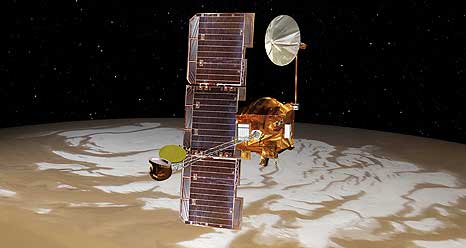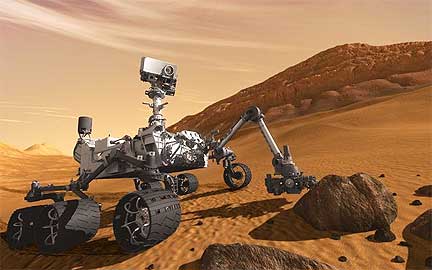
Artistic rendition of the Mars Odyssey, courtesy of NASA.
...to provide prompt confirmation of the August landing of the Curiosity rover. The Mars Science Laboratory (MSL) spacecraft carrying Curiosity can send limited information directly to Earth as it enters Mars' atmosphere. Before the landing, Earth will set below the Martian horizon from the descending spacecraft's perspective, ending that direct route of communication. Odyssey will help to speed up the indirect communication process.

This artist's concept depicts the rover Curiosity, of NASA's Mars Science Laboratory mission, as it uses its Chemistry and Camera (ChemCam) instrument to investigate the composition of a rock surface. Image courtesy of NASA.
Two other Mars orbiters, NASA's Mars Reconnaissance Orbiter (MRO) and the European Space Agency's Mars Express, will also be in position to receive radio transmissions from MSL during its descent. However, they will be recording information for later playback. Only Odyssey can relay information immediately.
Odyssey arrived at Mars in 2001. In addition to its own scientific observations, it has served as a communications relay for NASA's Spirit and Opportunity Mars rovers and the Phoenix lander. Spirit and Phoenix are no longer operational. Odyssey and MRO will provide communication relays for Curiosity during the rover's two-year prime mission. Odyssey and MSL, with its Curiosity rover, are managed by JPL for NASA's Science Mission Directorate in Washington. Curiosity was designed, developed and assembled at JPL. The Odyssey spacecraft is operated by JPL and Lockheed Martin in Denver. Lockheed Martin Space Systems in Denver built Odyssey.

